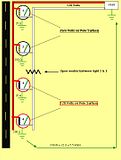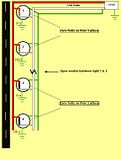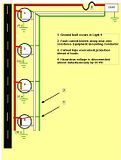- Location
- Windsor, CO NEC: 2023
- Occupation
- Hospital Master Electrician
Jon, since the NESC doesn't have an EGC at all, then the only acceptable way for the utilities to bond poles (aside from casting their book aside and picking up the NEC) is through the neutral.
The problem I see with that is, poles lend themselves to multiwire branch circuits (long runs, many heads), and neutrals made up by utility workers lend themselves to opening. (wink)
That would result in a shock hazard without a second fault. A MWBC would contribute to ballast damage also.
On a regular circuit, there would still be a shock hazard under an open neutral.

Click for enlarged image
In the picture above, I've drawn an open neutral between these poles, "1-4", on a regular L-N circuit. The poles are all bonded to the neutral. Poles 3 and 4 have 120V on their surface, due to having no path for the neutral current. Some will flow into the ground, but due to the high resistance, it's not effective. In one case, the fault clearing path was removed due to people experiencing shocks from the poles. We never heard back on that, but I'm fairly confident that the cause of the shocks was an open neutral.
Many pole lights are subjected to harsh conditions due to the measures we take to keep roads open in winter. Conductors deteriorate.

Click for enlarged image
By contrast, NEC poles will not shock on an open neutral between poles, as the EGC is not touching the neutral.
Anyway, that's all my opinion on it. If it were a perfect world, then the neutral-bonding would be as good. But it's not a perfect world, and I don't think it is.
I'm throwing this other picture on this thread just so all my eggs are in one basket.

Click for enlarged image
The problem I see with that is, poles lend themselves to multiwire branch circuits (long runs, many heads), and neutrals made up by utility workers lend themselves to opening. (wink)
That would result in a shock hazard without a second fault. A MWBC would contribute to ballast damage also.
On a regular circuit, there would still be a shock hazard under an open neutral.

Click for enlarged image
In the picture above, I've drawn an open neutral between these poles, "1-4", on a regular L-N circuit. The poles are all bonded to the neutral. Poles 3 and 4 have 120V on their surface, due to having no path for the neutral current. Some will flow into the ground, but due to the high resistance, it's not effective. In one case, the fault clearing path was removed due to people experiencing shocks from the poles. We never heard back on that, but I'm fairly confident that the cause of the shocks was an open neutral.
Many pole lights are subjected to harsh conditions due to the measures we take to keep roads open in winter. Conductors deteriorate.

Click for enlarged image
By contrast, NEC poles will not shock on an open neutral between poles, as the EGC is not touching the neutral.
Anyway, that's all my opinion on it. If it were a perfect world, then the neutral-bonding would be as good. But it's not a perfect world, and I don't think it is.
I'm throwing this other picture on this thread just so all my eggs are in one basket.

Click for enlarged image
Last edited:

